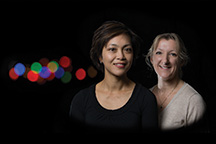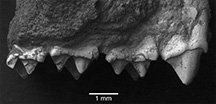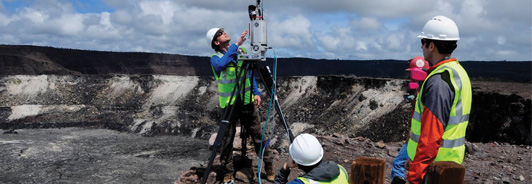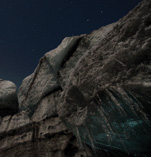Research
BBC Features UNC Professor, Student at Hawaiian Volcano
UNC researchers are continuing to take measurements of a Hawaiian volcano to better understand how it behaves and changes, and the dangers it poses. Their work at the Halemaumau crater was the subject of a BBC series on volcanoes that aired last summer. Professor Steven Anderson and graduate student Adam LeWinter used LiDAR (Light Detection and Ranging) to create a 3D map of the crater, and a new vent and lava lake (pictured bottom left). The Halemaumau crater is approximately 3,600 feet in diameter. The crater that opened in 2008 was roughly 525 feet in diameter and 158 feet deep at the time it was measured in February by researchers from the Army Corps of Engineers, the Hawaiian Volcano Observatory and UNC. By repeating measurements using LIDAR, which can penetrate thick steam and gas, Anderson and LeWinter can determine the rate the crater walls are disintegrating (erosion can cause large explosions when rock fall into the lava lake) and also track the lava lake level.
HOT SPOT: (Pictured above) Researchers (L-R) Ananda Fowler, Adam LeWinter and David Finnegan at a volcano in Hawaii use laser technology to map the crater, lava lake and new vent. Photo courtesy of Steven Anderson
Read Anderson’s first-person account and see his photos of an active volcano in Russia at www.unco.edu/news/?4216
 Chemist Expl oring Next Generation of LEDs
Chemist Expl oring Next Generation of LEDs
Assistant Professor of Chemistry Robin Macaluso is leading a grantfunded project that could result in more affordable, longer-lasting lightemitting diodes, or LEDs.
Macaluso and her team, which includes UNC graduate student Molly Jennifer Anderson, and a colleague from Oregon State University, will analyze an under explored class of materials known as pyrochlore oxynitrides, a ceramic that’s inexpensive to produce and shows promise for use in LEDs.
Macaluso’s team will conduct experiments in labs at UNC and Oregon State and at national neutron and X-ray scattering facilities. Photo by Barry LaPoint
Read the full story at www.unco.edu/news/?4076
 Junne to Receive National Award
Junne to Receive National Award
Africana Studies Professor George Junne, who released a book this fall about the real story behind the Civil War movie Glory, was also recognized by The Council of the Paleontological Society for his archaeological contributions. Among his discoveries since 1981 are new species that have been named for him. That includes Macrocranion junnei — from a six-millimeter fossil of the carnivore’s jawbone and set of teeth (pictured) that Junne found in Wyoming’s Bighorn Basin. Photo of fossil courtesy of University of Michigan Museum of Paleontology
Read a profile of Junne at www.unco.edu/news/?4126
Research Shows Promise for Drug to Treat West Nile, Related Viruses
Susan Keenan, associate professor and director of the School of Biological Sciences, and Brian Geiss, assistant professor of Microbiology at Colorado State University, have filed a provisional patent for the technology they developed to produce a drug that can stop replication of West Nile, dengue and yellow fever viruses. These viruses continue to plague two-thirds of the world’s population and no clinically useful antiviral drugs are currently available.
Keenan has spent the past 10 years trying to find small molecules that inhibit the function of a protein or enzyme that’s essential for the survival of the viruses or parasites and that can be used as drugs to fight the illnesses.
The researchers screened large chemical libraries for molecules that inhibited this enzyme, then used computer modeling to identify molecules that were better able to bind to the viral protein. One of the molecules they found was able to reduce virus replication in cells by more than 1,000-fold.
Read the full story at www.unco.edu/news/?4019
Fast fact: The 3,545 cases of West Nile virus reported to the Centers for Disease Control through the first nine months of 2012 was the most for a nine-month period since 1999, when the virus was first detected in the United States.
Study Offers Tips for Parents
A UNC study published in School Psychology International concludes that parent expectations have a stronger effect on academic success than various forms of home-based parental involvement. Assistant Professor of School Psychology John Mark Froiland and Ph.D. student Aubrey Peterson, along with a University of Minnesota colleague, analyzed data involving more than 7,600 parents and children nationwide. Froiland offers the following tips.
Do:
- Read to children ages 2-5 every day. Explain the meaning of vocabulary words and frequently visit the library together.
- Express your hopes, from preschool to young adulthood, that your children will do well in school and pursue the highest degree they’re capable of (the study found that parent expectations that their kindergarten-aged children would succeed in college predicted eighthgrade achievement in math, reading and science.)
- Point them to the deeper purposes in learning — one of the greatest is to help others — throughout life.
Don’t:
- Nag them about grades and homework. In middle and high school, children often struggle with their independence and may perceive questions such as “Shouldn’t you go study right now?” as controlling.
- Emphasize grades and other rewards so much that children lose sight of the real value of learning.
- Allow your children to associate you solely with pressure and demands. It’s important to keep the relationship strong by spending time with your children and show unconditional love so that they know that they are accepted by you regardless of how well they perform in school.
Read the full story and study at www.unco.edu/news/?4165







